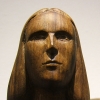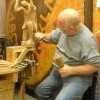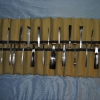The Sheffield List is the oldest, the most common and a model for the classification of woodcarving tools. You need to be able to find your way around this and similar charts easily, and thus the many shapes and forms in which woodcarving tools come.
With many thanks to member Steve Kay for compiling this document. Subscribing members can download a copy of the Sheffield List below.

| 18 March 2021 12:47
Andras - That's a big gouge, and not often made, so not often featured in the Sheffield List.
The best I can suggest is to download a PDF of the Ashley Iles catalogue from their website. They use the Sheffield list for their carving tools and you'll find the profiles in amongst the descriptions.
Here's the link: http://www.ashleyiles.co.uk/Catalogue.pdf
Thanks for the kind comments!

| 15 March 2021 17:24
Good morning Chris,
Would you be able to direct me to a Sheffield list up to 50mm chart please? I'd like to send it off to a Blacksmith to the Ukraine.
Thank you much for all you do and give,
Andras

| 05 April 2017 19:13
Benjamin - Yes, a 'true' gouge has a sweep that is an arc of a circle. However, when you push the edge into wood at an angle to its surface, what you actually get is an ellipse (think of the gouge as part of a cylinder, cut at an angle).
In practice, I only use numbers when I'm ordering tools; when carving, I just pick up the one that seems to work...

| 05 April 2017 13:20
Are the shapes/curves (those not U-shaped)parts of a circle or are they segments of an ellipse? I know it may sound like I'm being picky but it helps me in getting my head around the nature of selecting certain gouges. Thanks.

| 13 August 2016 20:22
Liam - Sure, buy what you need where you can. And always good quality. I know these things seem expensive but I've always seen them as an investment: 'The quality remains when the price is forgotten...' It also depends on whether you need a specific tool NOW, or just sometime whenever you find it?

| 11 August 2016 22:08
Hello Mr. Pye,
What is your opinion on purchasing used tools (carving tools and other woodworking tools like planes, rasps, rifflers, etc.) from auctions and such? It seems like a good way to save money, as long as the tools are good brands and in good condition?
Thanks,
Liam Hedrick

| 03 April 2016 18:06
Yes Chris, it's exactly what I do since the beginning. I didn't knew the Sheffield list before I saw it in your workshops! I just take a look and marked it like you've done with Pfeil.

| 03 April 2016 14:48
Liam - Sorry to be so slow replying; you slipped through my net somehow! My advice is to get carving with what you have, Then, when you find the tools won't do what you want, go to the Sheffield List and look for tools that WILL. I can well imagine you'll need a wider V tool, for example but you want to arrive at the conclusion yourself. I'm not ducking the question but this really is the best way forward.

| 03 April 2016 14:43
François - When I first got together with the new owners of, now bankrupt, Auriou, Auriou said they had been following the Sheffield list and stamping tools accordingly. However, they hadn't been, or perhaps had drifted away. When we put together some new tools I made sure they followed the list as I knew it. Hence the differences between 'old' Auriou and 'new'. The thing is, François, there are only 2 sorts of carving tools: those that are useful to you as a carver and those that aren't. The numbers will help when you want to buy a tool or tell someone (as on this site) what tool you are using but, really, I never actually look at the numbers; I just pick up the tool that works for me. So, my advice is to get carving and see if they are useful and, if they aren't, swap them for tools that are.

| 03 April 2016 10:03
Hello Chris, I noticed that the Auriou gouges sweeps - not the ones you design (I don't have one yet), the previous ones (before 2007) - are slightly different than the Sheffield list: #4=#5, #5=#6, #6 quicker than the #6, and the #8 is quicker than the #8, the others are the same. What do you think with the ones you have?

| 12 January 2016 09:26
Hello Mr. Pye,
This is Liam. In September, I purchased a set of six carving tools that had been recommended to me by a carving friend. They're made by Ramelson USA. They are as follows (according to the Sheffield List) : 1) Fishtail Gouge #6/8mm, 2) Straight Gouge #6/3mm, 3) V tool 60 degrees/3mm, 4) Skew Chisel 10mm, 5) Bent Chisel 10mm, and 6) Straight Chisel 10mm (all are sharpened except the V tool). So far, they have been good tools and have kept they're edges well, although I have only practiced a bit with them. Now that I have given you this information, I have a few questions for you. Given the tools that I already have, I have been thinking that it might be a good idea to purchase some larger gouges with different sweeps and a V tool. So, would you recommend that I purchase a flat gouge (#3/13mm), deeper gouge (#8 or #9/16mm), and then a larger V tool (11mm)? The sizes I just gave for the larger tools are not specific, they are simply ones I have been looking at. I apologize for the length of my comment, but I would like your advice. (:
Thanks so much,
Liam Hedrick

| 12 January 2016 09:23
Liam (Brian) - Assuming the tools you have work for you as a carver, just get carving. Then, when you find these tools are the wrong shape, width or sweep for what you want to do, work out what you DO need by comparing on the Sheffield list and buy that/those. This way you build up a unique set based on what you are doing and don't buy tools you don't use!

| 12 January 2016 09:21
Mr. Pye,
I apologize - I think my question was a little confusing, and I see what you mean about building up a set unique to my work. I guess what I was trying to get across was that the tools I have now are extremely small, so I have already found (albeit only from practicing) that bigger tools, especially a larger v tool, would be very helpful. So, your reply tells me that I think I need to purchase a v tool, and possibly a few gouges as well.
Thanks,
Liam Hedrick
P.S. By the way, in case you're confused, I (Liam) am the carver, and I am signed up using my Dad's (Brian's) account.

| 19 June 2015 09:10
I've added a Pfeil-Sheffield List comparison chart to the About > Downloads. Pfeil is a common brand and it's system of numbering is a bit different to the Sheffield List that I use to specify tools on the site and several of you have asked for clarification. I hope this helps! Let me say that, with very few exceptions, as long as you have tools that look reasonable close you should be able to follow what I do.

| 12 May 2014 01:32
Hey Chris - thanks for the response. I live in the U.S along the east coast I will do as you recommended and start small. Thanks again

| 11 May 2014 11:35
Peter - Some firms will make you anything from the SL, Henry Taylor for one, but manufacturers generally want to make and sell the most commonly used ones. I don'y know where you ive but, with the internet you can get tools sent anywhere today. Start small, say with that 11 piece set I recomend in my books and elsewhere, and build up your kit using the SL as a guide as you need them. The SL covers a wide range of possible carving wotk whereas you might oly ever need a few if you are working on a limited size or type of carving. Have fun with your carving!

| 10 May 2014 14:15
Hi Chris - I'm new to wood carving and am curious. Does anyone make a complete set of tools that can be bought that consists of the entire Sheffield tool list? It is very difficult to find tools where I live due to the fact that nobody sells them locally. Thanks

| 13 April 2014 19:44
James - Yes, it is a bit short to spend to much time on this when there's all that carving just waiting for you! There is actually a geometry, and formula but, although I had it explained, I can't recall. #9 is indeed a semicircle; I don't know about the #3. When I'm carving, I never consider the numbers, I just pick up the tool that I think would work. The numbers are mainly of use when ordering and buying tools.

| 12 April 2014 06:13
Hi Chris,
The math of each sweep's curvature has me intrigued. I know life is short, but I'm a scientist for my day job, so I can't help it! It seems that for a given sweep, the sweep number is a simpler way of stating how much of a full circle you get regardless of gouge width. In other words, an arc/circumference ratio. #3 would give an arc that is 1/100 (just a guess) of a full circumference, while a #9 gives a ratio of 1/2 (since it is a semi-circle).
Does that sound about right?

| 31 January 2014 08:57
Raul - If you stab each gouge into clean wood then shunt the cut around to form an arc, you'll see the arcs have different radiuses! This means that your number 3's, say, are not just different arcs from the same diameter circle, which is what most of us expect (including me when I started). It's true for all the Sheffield list numbers. Not only that but here's something else: put all the arcs of the number 6's, say, together and you get a spiral! (Ok, a helix, really.) I have had the geometry/maths of the numbering system explained to me, but... life's too short. Something about the depth changing in proportion to the width - there, that's enough. I never think of the numbers when I am carving. Unless I do need an exact sweep and width, say for a moulding, I just go by feel and instinct: 'That's the one I need'... The point is, your number 3's are each a distinct tool, with a distinct cut - and you become familiar with them as individuals as you carve a lot.

| 29 January 2014 06:13
Chris, I have some gouges PFEIL, I have a 3/10 and another gouge 3/20. The width of the gouge is double. Why not have the same curve? What is the difference between 3/10 and 3/20?

| 08 January 2014 06:44
Ann - Fishtails ARE in the Sheffield List (look at my books) but the numbers are funny and you don't need to work with anything other than the 1 - 11. All you need to know is that you can get any of your regular tools as a fishtail - but different makers use various ways of specifying it. I'd get the catalogue/sweep diagram of the maker you are wanting to buy from and use your regular gouges to make your sweep and width choice.

| 06 January 2014 14:33
If I could jump in - I'm having trouble understanding the Stubai (Sheffield?) #'s, especially in looking for fishtail gouges that aren't on the Sheffield List as far as I can see...

| 04 November 2013 08:10
Clive and Jeanne - With the exception of mouldings and lettering, a tool that is somewhere near what I am using will almost certainly do. I put the numbers on the lessons because I think it's not often clear exactly what I'm using. When I carve I usually just pick up the tool that looks like what I want, and you'll no doubt just do this too when you have enough to choose from. The numbers are really most useful for ordering.

| 01 November 2013 07:47
Thank you Chris. I've felt some frustration when a project would make reference to the #s. Since I bought my first tools from different makers to see what style handle suited my small hands. And I too appreciate checking the chart to see what works and will be noting what I have on the chart.

| 22 August 2013 13:20
In my own humble opinion I think that, the numbers are only really handy/useful if you going to faithfully follow a project.. I like to think of Project has a guide/inspirational incentive and the tools used as a guide; choice and use of tools are very personal choice.

| 09 August 2013 14:11
Henry - There isn't one I know of, I'm afraid. Have a look at the 2 comments immediately above. I would add this: you really don't want to get hung up on the numbers, and you certainly don't want to feel dependant on them for that very reason that they vary between manufacturers as you know. Rather, use whatever tools you have. Then, when you find you reach a limit - a tool comes close but doesn't quite do the job you want - ask yourself, what changes would be needed to make it work? Wider but the same sweep? Narrower and deeper? Shallower and bent in some way? Then go to the tool chart of your chosen manufacturer and work out what tool you need. This way you only need the number to place an order. Away with confusion! Cut straight to the chase...

| 08 August 2013 16:02
Is there are chart that gives the conversion between the Sheffield system and the Swiss system? I have all Swiss Made chisels and it can get confusing.

| 21 March 2012 08:47
Hi, I really like the idea you gave of checking the chart to see what works, instead of me buying more and more tools.........that may not even work for what I want to do. Thank you,
Arlabelle

| 22 November 2011 20:45
Bill - yes, it's Sheffield List in the projects etc. Pfeil are indeed out of sync with the Sheffield list but the sweeps are there none-the-less. Best thing is to make a photocopy of the Sheffield List from my book, say, and use that to compare with the Pfeil sweeps or catalogue. I should add that although I do flash the tool I'm using in the projects, it's only because I know you'll ask! Mostly 'something like that' will do a just as well. Although familiarity with the numbering is useful, I rarely look at the numbers when I carve, just the sweep - and will it do what I want it to do...

| 21 September 2011 16:27
Chris, I'm happy to see you are NOT trying to make these videos "perfect" in all ways. To see you get tongue tangled is natural and comes across well to me. If you can goof up your words, like I do, then maybe some day,when I grow up, I can maybe carve as well as you, kinda-sorta...
swalker